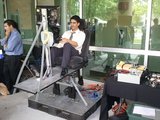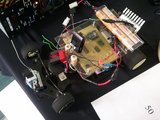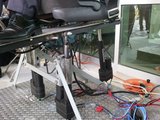We've already covered the 10-foot plasma-guided rocket and aerodynamic farings for two bicycles. What else did we see at the SDS?
Well, how about this life-size remote control and model car?
I've wanted to do this sort of thing with a model airplane forever. Shouldn't be too hard, I figured: just add a wireless camera, and build a cockpit-shaped box with big joysticks for the controls. Voila! Real flying action!
These guys went a step farther. They put some accelerometers on their car, then hooked the whole thing to a custom-made motion base!


Indeed, the concept is pretty simple: put a camera on the car, and give the user a video screen to watch so he sees what the car sees. For added realism, rig the controller to a steering wheel and a gas pedal. Kick it up that extra notch by mounting everything in the same place it would be in a real car.
But these guys brought it over the top! They added accelerometers to the model car, which tell them the orientation of the car at any time. Then they built a motion base that tilts the same way!

Here's a closeup of the motion base. You can see that this wasn't their initial design: there are mounting brackets slightly farther out than the ones the actuators are currently installed in. One of the mechanical engineers had to convince the others that they didn't need a full "six-degrees-of-freedom", and the base would be more responsive with the actuators pushing straight up.
They let Melissa have a go at it. They were only demonstrating their debug mode, of course. (Wouldn't want people ramming the car into strangers.) Turn the wheel, and the motion base tilts to the side. Press the accelerator, and the base tilts up. The video at the top of the page is her getting on; here's one of the end of her ride:
Apparently one of the team members had a stronger stomach, because when he demos it, he goes all out!
I thought I had a picture of their power electronics, but I've lost it. You could hear the clicks as they actuated their ... actuators.
With all the electronics, you'd think they'd need an electrical engineer on the team. But no; this group was all mechanical engineers. One of them did crash study what they needed for the big power box, though.
That's definitely a common theme among the teams at this SDS: engineers of all types, cross-studying to accomplish their goals.
Stick around for real-world engineering projects!